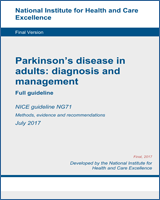NCBI Bookshelf. A service of the National Library of Medicine, National Institutes of Health.
Parkinson’s disease in adults: diagnosis and management. London: National Institute for Health and Care Excellence (NICE); 2017 Jul. (NICE Guideline, No. 71.)
D.1. Information needs of people with Parkinson’s disease and their families and carers
D.1.1. Impulse control behaviours
Download PDF (201K)
D.1.2. Women of childbearing age
Download PDF (185K)
D.2. Pharmacological management of motor symptoms
D.2.1. First-line treatment of motor symptoms
Download PDF (2.5M)
D.2.2. Adjuvant treatment of motor symptoms
Download PDF (457K)
D.3. Pharmacological management of non-motor symptoms
D.3.1. Daytime hypersomnolence
Download PDF (294K)
D.3.2. Nocturnal akinesia
Download PDF (217K)
D.3.3. Orthostatic hypotension
Download PDF (379K)
D.3.4. Psychotic symptoms (hallucinations and delusions)
Download PDF (1.1M)
D.3.5. REM sleep disorder behaviour
Download PDF (188K)
D.3.6. Thermoregulatory dysfunction
No evidence found for this question
D.4. Pharmacological management of dementia associated with Parkinson’s disease
Download PDF (829K)
D.5. Non-pharmacological management of motor and non-motor symptoms
D.5.1. Physiotherapy and physical activity
Download PDF (771K)
D.5.2. Occupational therapy
Download PDF (204K)
D.5.3. Speech and language therapy
Download PDF (222K)
D.5.4. Nutrition
Download PDF (1.2M)
D.6. Advanced therapies: deep brain stimulation and levodopa–carbidopa intestinal gel
D.6.1. Brain stimulation, levodopa–carbidopa intestinal gel and best medical treatment for advanced Parkinson’s disease
Download PDF (768K)
D.6.2. Deep brain stimulation compared with best medical treatment for earlier Parkinson’s disease
Download PDF (408K)
D.7. Managing and monitoring impulse control disorder as an adverse effect of dopaminergic treatment
D.7.1. Predictors for the development of impulse control disorders
Download PDF (787K)
D.7.2. Managing dopaminergic treatment in people who have developed impulse control disorder
Download PDF (362K)
D.8. Palliative Care
Download PDF (310K)
- Information needs of people with Parkinson’s disease and their families and carers
- Pharmacological management of motor symptoms
- Pharmacological management of non-motor symptoms
- Pharmacological management of dementia associated with Parkinson’s disease
- Non-pharmacological management of motor and non-motor symptoms
- Advanced therapies: deep brain stimulation and levodopa–carbidopa intestinal gel
- Managing and monitoring impulse control disorder as an adverse effect of dopaminergic treatment
- Palliative Care
- Evidence tables - Parkinson’s disease in adults: diagnosis and managementEvidence tables - Parkinson’s disease in adults: diagnosis and management
- WW domain-containing oxidoreductase isoform 1 [Homo sapiens]WW domain-containing oxidoreductase isoform 1 [Homo sapiens]gi|7706523|ref|NP_057457.1|Protein
Your browsing activity is empty.
Activity recording is turned off.
See more...
